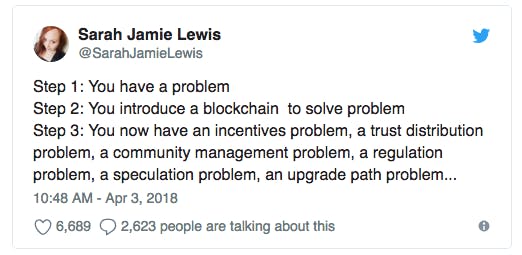Blockchain. You’ve probably heard of it. In 2017, the technology hit the peak of Gartner’s ‘hype cycle’ of emerging technologies – ahead of autonomous vehicles, connected homes and smart robots.
According to its fans, blockchain is set to revolutionise everything, from banking systems and stock exchanges to property registries, contract law and corporate sustainability.
It’s an exciting-sounding prospect – and one persuasive enough to attract $3 billion in investment last year alone. Companies such as Coca-Cola, Walmart and Unilever have launched pilot projects to use the technology to tackle labour rights issues, improve food safety and promote sustainable agriculture.
So is blockchain more than just hype? Should sustainability officers be studying up on the difference between a block, a fork and a node? Or is it just another tech bubble on the way to bursting?
Blockchain 101
According to one definition, a blockchain is “a shared record of information that is maintained and updated by a network of computers rather than a central authority. It is protected and secured by advanced cryptography.”
How does that work in practice? Take blockchain’s best-known use, the digital currency Bitcoin. Each transaction made using Bitcoin is recorded as a ‘block’ on an ever-growing public ledger – the blockchain. Computers around the world compete with each other to verify each transaction by solving a complex algorithm, making fraudulent behaviour easy to spot.
While in many ways blockchains work just like old-fashioned databases, the key selling-point is that there is no need any central authority – whether government, private business or third-party intermediary – to oversee, validate and regulate the data. As we’ll see, this has its pros and cons.
“
The message is clear and intuitive – blockchain may be overhyped now, but it will eventually lead to real and meaningful impacts.
How do you solve a problem with a blockchain?
If you believe its advocates, about the only thing blockchain isn’t great at is underpinning a digital currency. This was the view taken by a New York Times article in January 2018: “The paradox about Bitcoin is that it may well turn out to be a genuinely revolutionary breakthrough and at the same time a colossal failure as a currency”
This view was also the prevailing one at this year’s World Economic Forum in Davos, from luminaries such as Nobel Prize-winning economist Robert Shiller. In fact, the opinion was so much the consensus at Davos that it was ripe for parody:

Banking was one of the first industries to succumb to Bitcoin-mania. In 2014, the Bank of England suggested that blockchain could become the “internet of finance”. According to Brian Behlendorf, executive director of open-source project Hyperledger, blockchain enables banks to do “a lot of what they do today… just faster and cheaper and with greater guarantees”. Beyond banking, blockchain’s impact on efficiency and transparency is touted everywhere from shipping and insurance to the legal sector.
Blockchain’s adoption in sustainability circles is for similar reasons. Blockchain promises to enhance visibility along complex supply chains, from diamonds to tuna to tea. Other areas associated with challenges in traceability and record-keeping – including green energy procurement and food waste – are also on blockchain’s radar.
When even Reuters is raving about the potential of “disintermediating traditional supply chains and, in turn, upending decades-old regulatory structures”, it’s hard not to get swept up in the hype. Yet the next stage in the Gartner hype cycle is the “trough of disillusionment”. The recent surge of investment in blockchain bears many hallmarks of a classic tech bubble. So who are blockchain’s critics, and will they be proved right?
The trouble with blockchain
Blockchain’s critics aren’t just from the traditional industries under threat from tech startups. Instead, many can be found in the tech industry itself. They can be broadly split into two camps – purists and naysayers.
First, the purists – those who insist that while the promise of blockchain is real, it’s not being implemented properly. Businesses are put off by the open, distributed nature of the blockchain, and seek to dilute it. As the Financial Times puts it: “Regulated industries [value] privacy, cost-control, scale, competition, autonomy, legal recourse and compliance. By now almost all blockchain ventures have absolutely nothing to do with blockchain as it was originally described or used in Bitcoin.”
The purists argue that by attempting to control the blockchain, businesses and regulators have undermined any benefit they would have received from it. All that they are left with is a new kind of private database – one that is no more secure or reliable than a traditional one.
The second group of blockchain critics are the naysayers. They disagree not just with the way that blockchain is implemented, but with the technology itself. Far from being a panacea for all problems of transparency and traceability, they argue, the blockchain actually creates more problems than it solves:

In a widely-shared blog, financial services CEO Kai Stinchcombe argues that blockchain is an imperfect solution for many of the problems it claims to solve. In the end, he says, “Blockchain enthusiasts often act as if the hard part is getting money from A to B or keeping a record of what happened. In each case, [this] is actually the cheap, easy, highly-automated part of a much more complex system.”
As blockchain slides towards the “trough of disillusionment” on the hype cycle, there are signs that some of these criticisms are starting to hit home. Goldman Sachs, Banco Santander, JP Morgan and Deutsche Boerse all cut their involvement in various blockchain consortia in 2017. Is it time for blockchain enthusiasts to face the writing on the wall?
Blockchain and sustainability – where next?
Gartner’s hype cycle doesn’t end at the trough of disillusionment. The trough flattens out, leading to the “slope of enlightenment” and eventually the “plateau of productivity”. The message is clear and intuitive – blockchain may be overhyped now, but it will eventually lead to real and meaningful impacts.
The hype is already leading to exciting and innovative collaborations. Coca-Cola has partnered with the US State Department to combat forced labour in supply chains. Unilever and Sainsbury’s are working with BNP Paribas and Standard Chartered to track and reward sustainable agricultural practices.
In this context, does it matter that “blockchain” is in many cases a buzzword meaning little more than “shared database”? Princeton professor Arvind Narayanan argues this point, saying that when it comes to blockchain, “the hype is the core value proposition, not the technology.”
Companies must remember what a blockchain is – a secure, distributed, open database – and what it is not. The economist Hernando de Soto, who advocates using blockchains as property registries, warns that the technology by itself is not a “magic bullet”. Kai Stinchcombe elaborates: “Blockchain systems do not magically make the data in them accurate or the people entering the data trustworthy… A person who sprayed pesticides on a mango can still enter onto a blockchain system that the mangos were organic.”
Blockchain promises to help organisations achieve a significant shift in accountability and transparency. Startups such as ESG Ledger, Provenance and Giftcoin are all founded on using the technology to make in-depth data more visible to consumers. Your first step should be to work out whether and how this will help you achieve your sustainability goals.
If you’re considering using a blockchain, think to yourself: “do I really need an open, distributed database to achieve this, or do I just need a database?” If the answer is the latter, you’ve just saved yourself a lot of effort. If it is the former, you must be prepared for a more radical, open form of transparency than you have ever tried before.
Charlie Ashford is a Consultant at Corporate Citizenship.


















